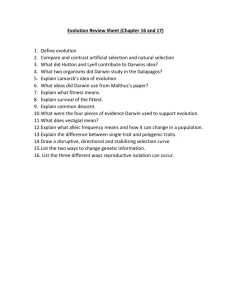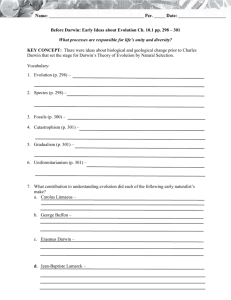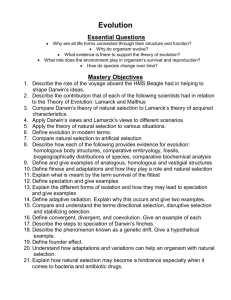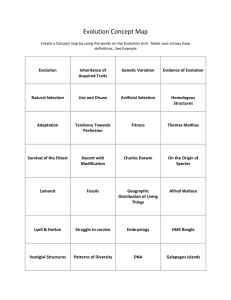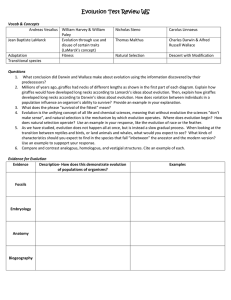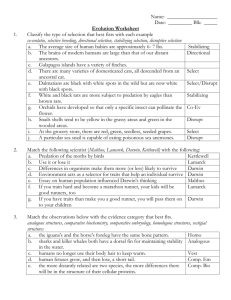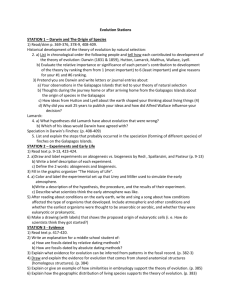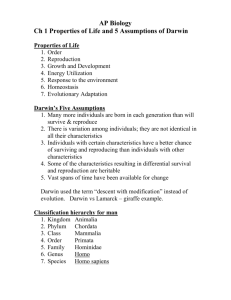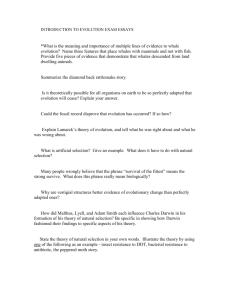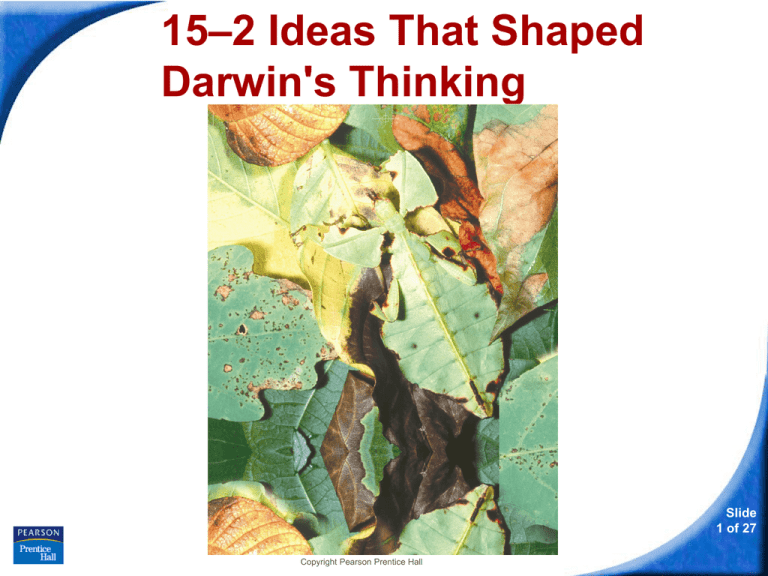
15–2 Ideas That Shaped
Darwin's Thinking
Slide
1 of 27
Copyright Pearson Prentice Hall
15–2 Ideas That Shaped
Darwin's Thinking
An Ancient, Changing Earth
Hutton and Geological Change
In 1795, James Hutton published a hypothesis
about the geological forces that shaped Earth.
Most of these geological forces operate very
slowly, over millions of years.
Hutton proposed that Earth had to be much more
than a few thousand years old.
Slide
2 of 27
Copyright Pearson Prentice Hall
15–2 Ideas That Shaped
Darwin's Thinking
An Ancient, Changing Earth
Lyell's Principles of Geology
Lyell stressed that scientists must explain past
events in terms of processes that they can actually
observe.
The processes that shaped the Earth millions of
years earlier continue in the present.
Lyell’s work explained how geological features
could be built up or torn down over long periods of
time.
Slide
3 of 27
Copyright Pearson Prentice Hall
15–2 Ideas That Shaped
Darwin's Thinking
An Ancient, Changing Earth
This understanding of geology influenced Darwin:
• If the Earth could change over time, life might
change as well.
• It would have taken many years for life to change
in the way Lyell suggested.
This would have been possible only if the Earth were
extremely old.
Slide
4 of 27
Copyright Pearson Prentice Hall
15–2 Ideas That Shaped
Darwin's Thinking
Lamarck's Evolution Hypotheses
Lamarck's Evolution Hypotheses
Jean-Baptiste Lamarck recognized that:
• living things have changed over time.
• all species were descended from other
species.
• organisms were adapted to their environments.
Slide
5 of 27
Copyright Pearson Prentice Hall
15–2 Ideas That Shaped
Darwin's Thinking
Lamarck's Evolution Hypotheses
Lamarck proposed that by selective use
or disuse of organs, organisms acquired
or lost certain traits during their lifetime.
These traits could then be passed on to
their offspring. Over time, this process
led to change in a species.
Slide
6 of 27
Copyright Pearson Prentice Hall
15–2 Ideas That Shaped
Darwin's Thinking
Lamarck's Evolution Hypotheses
Tendency Toward Perfection
Lamarck proposed that all organisms have an
innate tendency toward complexity and perfection.
They are continually changing and acquiring
features that help them live more successfully in
their environments.
Slide
7 of 27
Copyright Pearson Prentice Hall
15–2 Ideas That Shaped
Darwin's Thinking
Lamarck's Evolution Hypotheses
Use and Disuse
Lamarck proposed that organisms could alter the
size or shape of particular organs by using their
bodies in new ways.
Slide
8 of 27
Copyright Pearson Prentice Hall
15–2 Ideas That Shaped
Darwin's Thinking
A male fiddler
crab uses its front
claw to ward off
predators and to
attract mates.
Lamarck's Evolution Hypotheses
Lamarck's Hypothesis
Slide
9 of 27
Copyright Pearson Prentice Hall
15–2 Ideas That Shaped
Darwin's Thinking
Because the front
claw is used
repeatedly, it
becomes larger.
Lamarck's Evolution Hypotheses
Lamarck's Hypothesis
This characteristic
(large claw) is
passed onto its
offspring.
Slide
10 of 27
Copyright Pearson Prentice Hall
15–2 Ideas That Shaped
Darwin's Thinking
Lamarck's Evolution Hypotheses
Inheritance of Acquired Traits
Lamarck thought that acquired characteristics
could be inherited.
He believed that if an animal acquired a particular
feature in its lifetime, that feature would be passed
on to its offspring.
Slide
11 of 27
Copyright Pearson Prentice Hall
15–2 Ideas That Shaped
Darwin's Thinking
Lamarck's Evolution Hypotheses
Evaluating Lamarck's Hypotheses
Lamarck’s hypotheses of evolution are incorrect in
several ways.
Lamarck did not know:
• how traits are inherited.
• that an organism’s behavior has no effect on
its heritable characteristics.
However, he paved the way for the work of later
biologists.
Copyright Pearson Prentice Hall
Slide
12 of 27
15–2 Ideas That Shaped
Darwin's Thinking
Population Growth
Population Growth
In 1798, Thomas Malthus published a book in
which he noted that babies were being born faster
than people were dying.
The only forces he observed that worked against
this growth were war, famine, and disease.
Slide
13 of 27
Copyright Pearson Prentice Hall
15–2 Ideas That Shaped
Darwin's Thinking
Population Growth
Malthus reasoned that if the human
population continued to grow
unchecked, sooner or later there would
be insufficient living space and food for
everyone.
Slide
14 of 27
Copyright Pearson Prentice Hall
15–2 Ideas That Shaped
Darwin's Thinking
Population Growth
When Darwin read Malthus’s work, he realized that
this reasoning applied to plants and animals.
If all the offspring of almost any species survived for
several generations, they would overrun the world.
This information was central to Darwin’s explanation
of evolutionary change.
Slide
15 of 27
Copyright Pearson Prentice Hall
15–2 Ideas That Shaped
Darwin's Thinking
Slide
16 of 27
Copyright Pearson Prentice Hall

